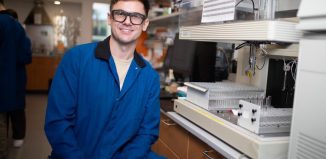Glass provides pleasant surprise for solar scientist

If he succeeds, she may see the results of his efforts in her work. As fascinated as she is by her studies in the Antarctic, Heather Lynch knows the stakes are high for her husband Matthew Eisaman’s work.
“These days, ecologists like myself are often just carefully documenting environmental decline, and predicting how quickly or slowly a species will go extinct,” Lynch offered in response to emailed questions. “The work that [Eisaman] does will actually solve the problem.”
Indeed, as a physicist in the Sustainable Energy Technologies Department at BNL and an assistant professor in the Department of Electrical and Computer Engineering at Stony Brook University, Eisaman is focused on improving the efficiency of reusable energy sources, particularly solar cells.
It is through this effort that Eisaman made a compelling discovery recently that may have implications outside the world of reusable energy.
Eisaman worked with a team of scientists at BNL and the Colleges of Nanoscale Science and Engineering at SUNY Polytechnic on a process related to graphene, which is a two-dimensional arrangement of carbon atoms that is one atom thick.
Eisaman was working on a process called doping in which scientists add or take away electrons. Doping is one way to control how graphene behaves at junctions with semiconductors. Eisaman set up an experiment to explore a way to make n-doping, which adds electrons to graphene, more efficient.
The team at SUNY Polytechnic built a product on top of a sodium lime substrate, which is an ingredient in household glass and windows. Eisaman layered graphene on top of that. He had planned to add other chemicals to dope the graphene.
“Before we doped it, we took a baseline measurement,” Eisaman said. “It looked like it was strongly n-doped, which we didn’t expect.” He followed this up with a series of other experiments, using the facilities at BNL including the Center for Functional Nanomaterials, at SUNY Poly and in his lab. “The whole study was really a team effort requiring many different areas of expertise.”

Eisaman believes this discovery was promising for solar cells and other possible technological advances. He plans to explore the fundamentals of the doping mechanism. He would like to understand how the chemical environment of the sodium affects the doping strength. He is also studying how the doping and other electronic properties of the graphene vary with the number of graphene layers.
Eisaman said one challenge to making this doping process work is that most semiconductor properties would change, mostly for the worse, if scientists tried to diffuse sodium through it. A possible solution is to deposit a material on top of the graphene that has a sufficiently high surface density of sodium. While this material would donate electrons to the graphene, it would not diffuse into the semiconductor as long as the temperatures of the deposition process were low enough, Eisaman suggested. He is currently working on this.
Since the paper came out in Scientific Reports in February, Eisaman said he has had inquiries from scientists and from a company that might want to use their discovery. He is “actively looking for funding and partnerships to help push this forward,” he said.
Eisaman has three Ph.D. candidates in his lab and he usually adds two to four undergraduate researchers in the summer. While this group will continue to develop technology that will seek ways to find applications of graphene doping techniques, Eisaman will continue with the bread and butter work in his lab: improving the efficiency of reusable energy alternatives.
In another set of experiments, Eisaman collaborated with Charles Black, a scientist and group leader at the Center for Functional Nanomaterials. Black and Eisaman worked on how to use the same anti-reflective properties in moth eyes to reduce the amount of light that escapes from a solar cell through reflections.
Black constructed structures that mimicked these properties. The structure worked even better than expected.
“Based on our limited knowledge of optics, which is [Eisaman’s] expertise, we couldn’t understand why they seemed to be doing better than we thought they should,” Black said. Eisaman’s complementary ability to model the optical properties of the material on the computer allowed them to see a “subtlety that escaped us. In the end, he figured out what was going on.” Black and Eisaman are continuing to work together to create a better structure.
Eisaman and Lynch, an assistant professor in the Department of Ecology and Evolution at Stony Brook, have a 6-year old daughter Avery. They live in Port Jefferson, where they have had solar panels on their house for over a year.
The couple, who met when they were undergraduates at Princeton, discuss their work “constantly,” Lynch noted. “Sometimes, we sit and brainstorm how to solve the world’s energy problems, by which I mean that I throw out crazy ideas and [Eisaman] patiently explains why they wouldn’t work or why they don’t scale well.”
Eisaman, who grew up in Pittsburgh, said he appreciates being close to the water, where he and Lynch have enjoyed kayaking since they moved to Long Island in 2011. Eisaman and Lynch are recreational runners and try to run two marathons each year: the Pineland Farms Trail Race in Maine and the Hamptons Marathon.
As for his work, Eisaman said he feels a sense of urgency. “One of the most pressing problems we’re facing is to meet our energy goals in the next 10 to 20 years.”






